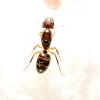So I want to start ant keeping and i found a nest in my front yard but i don't know what species it is. I live in the midwest in the US. The ants are a shiny black and the workers are 5 mm long. They don't seem to have variations in size. I have not seen the queen yet. The workers seem to have a yellowish stripe on their back. they don't travel very fast and i don't know if this helps, but they like honey. ![]()
Edited by FishFeet, April 5 2017 - 1:19 PM.





















